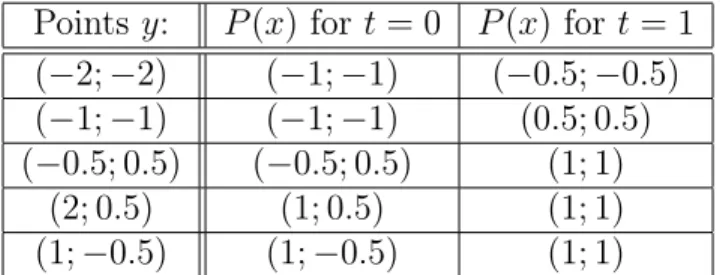Universität Konstanz Sommersemester 2013 Fachbereich Mathematik und Statistik
Prof. Dr. Stefan Volkwein
Roberta Mancini, Stefan Trenz, Carmen Gräßle, Marco Menner, Kevin Sieg
Optimierung
http://www.math.uni-konstanz.de/numerik/personen/volkwein/teaching/
Program 2
Submission by E-Mail: 2013/06/17, 10:00 h
Note: Stick to the given function and parameter definitions as described below!
You should not modify them in name or concerning the input and output arguments.
Implementation of the Projected Gradient Method.
Part 1: Generate a file projection.m and implement the function function [px] = projection(x, a, b)
with the current point x ∈ R n , lower bound a ∈ R n and upper bound b ∈ R n as input arguments. The function returns the (pointwise) projected point px ∈ R n according to the projection
P : R n → Ω := {x ∈ R n | ∀i = 1, ..., n : a i ≤ x i ≤ b i }.
Test your function for the rectangular 2-D domain defined by the lower bound (lower left corner) a = (−1; −1) and the upper bound (upper right corner) b = (1; 1): compute the projection P (x) of points x = y + td ∈ R 2 with y ∈ R 2 as given in the table below, direction d = (1.5; 1.5) ∈ R 2 , step sizes t = 0 and t = 1. For validation compare your results to the projections given in the table:
Points y: P (x) for t = 0 P (x) for t = 1 (−2; −2) (−1; −1) (−0.5; −0.5) (−1; −1) (−1; −1) (0.5; 0.5) (−0.5; 0.5) (−0.5; 0.5) (1; 1)
(2; 0.5) (1; 0.5) (1; 1)
(1; −0.5) (1; −0.5) (1; 1)
Table 1: Testing points and their projections with respect to t
Part 2: Write a function
function [t] = modarmijo(fhandle, x, d, t0, alpha, beta, a, b)
for the Armijo step size strategy with the modified termination condition f(x(λ)) − f(x) ≤ − α
λ ||x − x(λ)|| 2
with current point x, descent direction d, initial step size t0, alpha and beta for the Armijo rule and a and b for the projection rule.
Part 3: Implement the gradient projection algorithm with direction d k := − k∇f ∇f (x (x
k)
k
